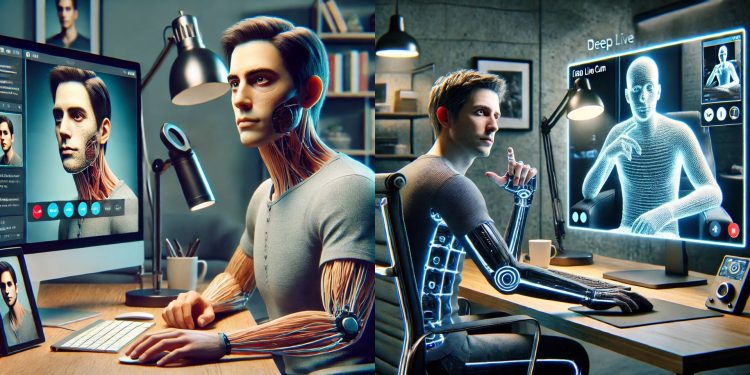Deep Live Cam technology has recently gone viral, both fascinating and suspicious users with its ability to turn anyone into a digital person. The new software allows users to transform into virtual twins in video chats using just a single photo and free software. And you can do it to anyone you want. Elon Musk, Mark Zuckerberg, and so on… a bit scary.
The buzz around Deep Live Cam has grown rapidly over the past few days. This innovative tool takes a face from a single image and applies it to a live webcam video, mimicking the pose, lighting, and expressions of the person on camera. While the results aren’t perfect, it demonstrates the rapid progress in this technology and highlight how easy it has become to create convincing digital impersonations.
Nice remember to establish code words with your parents everyone https://t.co/9hWLxMgtKF
— Corey Brickley Illustration. Justice for Palestine (@CoreyBrickley) August 13, 2024
Clicking faces: How Deep Live Cam works its magic
Deep Live Cam combines several existing software packages to achieve its face-swapping feat. Here’s a breakdown of the process:
- Face detection: The software identifies faces in both the source photo and the target video frames.
- Face swapping: It uses a pre-trained AI model called “inswapper” to perform the actual face replacement.
- Quality enhancement: Another model, GFPGAN, steps in to improve the swapped faces by enhancing details and fixing any glitches.
The core of Deep Live Cam’s functionality lies in its “inswapper” model. This smart piece of AI can predict how a person might look from different angles and with various expressions. It does this thanks to training on millions of facial images capturing thousands of people in different circumstances.
During its training, the inswapper model developed a deep understanding of facial structures and how they change under different circumstances. It learned to separate features that stay constant (like a person’s identity) from those that change (like pose and expression). This allows it to create new face images that blend one person’s identity with another’s pose and expression.
#1 trending github repo right now looks INSANE
Single image to live stream deep fake.
Look at that quality!!
It's called Deep-Live-Cam (link in replies) pic.twitter.com/VgtnJ1LKRM
— MatthewBerman (@MatthewBerman) August 9, 2024
From GitHub to your screen: The spread of Deep Live Cam
The Deep Live Cam project has been in development since late last year. Recently, however, it gained notoriety when sample videos showing real-time impersonations of well-known people started circulating on the internet. This surge of interest quickly propelled the open-source project to the top of GitHub’s trending repositories list.
The popularity of the software highlights the increasing accessibility of deepfake technology. What was once a costly and time-consuming process is now available to anyone with a regular computer and some free software. This democratization of face-swapping technology has caused both excitement and concern among internet users.
The rise of Deep Live Cam and similar technologies raises important questions about digital identity and online trust. As these tools become more widespread and sophisticated, it may become increasingly difficult to distinguish between real and fake video content.
Real-time deepfakes are here. I used the repo below to swap my face directly in my webcam feed as JD Vance, Hugh Grant, Zuckerburg, and George Clooney.
We know people have been using this kind of tech for malicious purposes… Don't trust your eyes, don't trust your ears. pic.twitter.com/iWvgtwtXLD
— joao (@jay_wooow) August 9, 2024
Some observers have noted the potential for abuse, particularly in the area of fraud and deception. There are concerns that malicious actors could use this technology to impersonate others in video calls, leading to fraud or identity theft.
However, it is worth noting that face-swapping is only one piece of the puzzle when it comes to persuasive imitation. Current limitations mean that mimicking someone’s voice, mannerisms, and body language is crucial for a truly convincing performance.
As Deep Live Cam and related technologies continue to evolve, it is clear that society will need to grapple with both the creative possibilities and potential pitfalls of this face-swapping revolution. Debate is likely to continue in the coming years about the ethical use of such tools and the development of safeguards against misuse.
Featured image credit: Furkan Demirkaya / Dall-E





